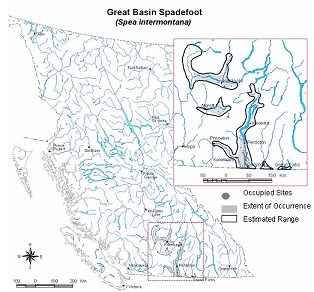The Great Basin Spadefoot is a primarily nocturnal, secretive, distinctive small toad, that is grey, brown or olive green in colour (Matsuda et al. 2006, Nafis 2009, British Columbia Southern Interior Reptile and Amphibian Recovery Team 2008). It has large golden yellow or 'brassy' eyes with vertical pupils that are set on the side of the head (Matsuda et al. 2006, Nafis 2009). Legs are short (Nafis 2009) and it 'has a short, upturned snout' (British Columbia Southern Interior Reptile and Amphibian Recovery Team 2008). It is often described as plump, round or stout (Matsuda et al. 2006, Nafis 2009, and others). According to Matsuda et al. (2006), this species has 'two indistinct and irregular bands bordering the back, and has small tuberacles or reddish-brown spots covering the back'. The tympana are small, and there is a distinctive bump between the eyes (BC Ministry of Environment 2009). The skin is bumpy but not warty as it is in Western Toads. Adult Great Basin Spadefoot Toads range from 4 -6.5 (7.0-7.5) cm long (BC Minisry of Environment 2009, Matsuda et al. 2006, Nafis 2009); males are smaller than females.
This species has a distinctive 'sharp-edged dark ridge (“spade”)' on the inner side of the hind feet which allows individuals to dig or buurrow into loose soil for shelter (BC Ministry of Environment 2009, BC, British Columbia Southern Interior Reptile and Amphibian Recovery Team 2008 ). This spade, and the vertical pupils, separate the Great Basin Spadefoot from the Western Toad, which has horizontal pupils.
Spea intermontana (Cope, 1883)
Great Basin Spadefoot
Family: Scaphiopodidae
Great Basin Spadefoot
Family: Scaphiopodidae
Photograph
© Virgil Hawkes (Photo ID #9881)
Introduction
|
Species Information
Identification and Subspecies Information
|
|
Biology
|
Habitat
|
Distribution
|
Conservation
|
Status Information
BC Ministry of Environment: BC Species and Ecosystems Explorer--the authoritative source for conservation information in British Columbia. |
Synonyms and Alternate Names
Scaphiopus hammondi intermontanus Cope, 1883 Scaphiopus intermontanus Cope, 1883 |
Taxonomic and Nomenclatural Links
Additional Range and Status Information Links
Additional Photo Sources
Species References
|
British Columbia Southern Interior Reptile and Amphibian Recovery Team. 2008. Recovery Strategy for the Great Basin Spadefoot (Spea intermontana) in British Columbia. Prepared for the B.C. Ministry of Environment, Victoria, BC Matsuda, Brent, David M. Green, and Patrick T. Gregory. 2006. Amphibians and Reptiles of British Columbia. Handbook. Royal BC Museum, Victoria. Morey, Steven R. 2009. Spadefoot Toad (Spea intermontana) Fact sheet. In: AmphibiaWeb: Information on amphibian biology and conservation. [web application]. 2009. Berkeley, California: AmphibiaWeb. Available: http://amphibiaweb.org/. (Accessed: Jul 24, 2009).
Nafis, Gary. 2009. CaliforniaHerps.com. California Reptiles and Amphibians: Spea intermontana:--Great Basin Spadefoot Toad. Available: http://www.californiaherps.com/index.html. |
